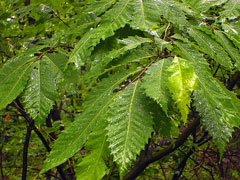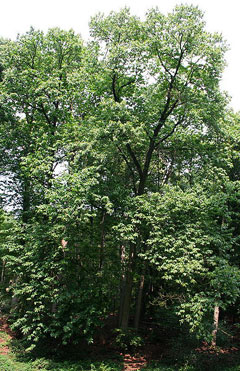 |
|
http://www.flickr.com/photos/nicholas_t/ |
 |
| http://commons.wikimedia.org/wiki/User:Jean-Pol_GRANDMONT |
Translate this page:
Summary
Physical Characteristics

 Castanea dentata is a deciduous Tree growing to 30 m (98ft) by 15 m (49ft).
Castanea dentata is a deciduous Tree growing to 30 m (98ft) by 15 m (49ft).
See above for USDA hardiness. It is hardy to UK zone 4. It is in flower in July, and the seeds ripen in October. The species is monoecious (individual flowers are either male or female, but both sexes can be found on the same plant) and is pollinated by Insects.
Suitable for: light (sandy), medium (loamy) and heavy (clay) soils, prefers well-drained soil and can grow in nutritionally poor soil. Suitable pH: mildly acid and neutral soils and can grow in very acid soils.
It can grow in semi-shade (light woodland) or no shade. It prefers dry or moist soil and can tolerate drought.
UK Hardiness Map
US Hardiness Map
Synonyms
C. americana.
Plant Habitats
Woodland Garden Canopy;
Edible Uses
Edible Parts: Oil Seed
Edible Uses: Chocolate Coffee Oil
Seed - raw or cooked[2, 62, 63, 102, 117]. Rather on the small side, but these are the sweetest seeds of any species in this genus[183]. The seed contains about 7% fat, 11% protein[159]. It can be dried, ground into powder and then be added to cereals when making bread, cakes etc[213]. A delicious oil can be extracted from the seed by crushing the nuts, boiling them in water and then skimming off the oil as it comes to the surface[213]. It can be used as a topping for various puddings[213]. The roasted nut can be used as a coffee substitute and a chocolate substitute can also be made from it[183] (no further details).
References More on Edible Uses
Medicinal Uses
Plants For A Future can not take any responsibility for any adverse effects from the use of plants. Always seek advice from a professional before using a plant medicinally.
Astringent Expectorant
A warm water infusion of the leaves has been used to calm the respiratory nerves and promote expectoration[213, 257]. The infusion has also been used in the treatment of whooping cough but modern opinion is that the leaves are no more than a mild astringent[213].
References More on Medicinal Uses
The Bookshop: Edible Plant Books
Our Latest books on Perennial Plants For Food Forests and Permaculture Gardens in paperback or digital formats.

Edible Tropical Plants
Food Forest Plants for Hotter Conditions: 250+ Plants For Tropical Food Forests & Permaculture Gardens.
More

Edible Temperate Plants
Plants for Your Food Forest: 500 Plants for Temperate Food Forests & Permaculture Gardens.
More

More Books
PFAF have eight books available in paperback and digital formats. Browse the shop for more information.
Shop Now
Other Uses
Dye Oil Tannin Wood
The bark is a good source of tannin[46, 61, 171, 223]. The dried leaves contain 9% tannin[213]. The wood and the seed husks also contain tannin[223]. The husks contain 10 - 13% tannin[223]. A brown dye is obtained from the bark[257]. Wood - soft, not strong, light, very durable, liable to warp. It weighs 28lb per cubic foot. Easy to split, it is used for making cheap furniture, fence posts, in construction etc[61, 82, 117, 171, 229, 235].
Special Uses
Food Forest
References More on Other Uses
Cultivation details
Prefers a good well-drained slightly acid loam but succeeds in dry soils and in hot sunny sites[1, 11, 188, 200]. Once established, it is very drought tolerant[11, 200]. Very tolerant of highly acid, infertile dry sands[200]. Averse to calcareous soils but succeeds on harder limestones[11, 200]. Although it is very winter-hardy, this species only really thrives in areas with hot summers[200]. A tree at Kew in 1985 was 15 metres tall and thriving[11]. At one time widely cultivated in N. America for its edible seed, it is now virtually extinct in the wild due to chestnut blight[11]. There are some named varieties[183]. Trees are possibly becoming resistant, some suckering stands in America are producing fruit[11]. Suckers often reach 4 - 6 metres tall before succumbing to blight, but they rarely manage to produce fruit[229]. An excellent soil-enriching understorey in pine forests[200]. Flowers are produced on wood of the current year's growth[229]. Plants are fairly self-sterile[200]. They hybridize freely with other members of this genus[200]. Plants in this genus are notably resistant to honey fungus[200]. For polyculture design as well as the above-ground architecture (form - tree, shrub etc. and size shown above) information on the habit and root pattern is also useful and given here if available. The plant growth habit is a standard with a non-suckering single trunk [1-2]. The root pattern is a tap root similar to a carrot going directly down [1-2].
References Carbon Farming Information and Carbon Sequestration Information
Temperature Converter
Type a value in the Celsius field to convert the value to Fahrenheit:
Fahrenheit:
The PFAF Bookshop
Plants For A Future have a number of books available in paperback and digital form. Book titles include Edible Plants, Edible Perennials, Edible Trees,Edible Shrubs, Woodland Gardening, and Temperate Food Forest Plants. Our new book is Food Forest Plants For Hotter Conditions (Tropical and Sub-Tropical).
Shop Now
Plant Propagation
Seed - where possible sow the seed as soon as it is ripe in a cold frame or in a seed bed outdoors[78]. The seed must be protected from mice and squirrels. The seed has a short viability and must not be allowed to become dry. It can be stored in a cool place, such as the salad compartment of a fridge, for a few months if it is kept moist, but check regularly for signs of germination. The seed should germinate in late winter or early spring. If sown in an outdoor seedbed, the plants can be left in situ for 1 - 2 years before planting them out in their permanent positions. If grown in pots, the plants can be put out into their permanent positions in the summer or autumn, making sure to give them some protection from the cold in their first winter[K].
Other Names
If available other names are mentioned here
Native Range
NORTHERN AMERICA: Canada, Ontario (south), United States, Connecticut, Indiana (south), Maine (south), Massachusetts, Michigan (southeast), New Hampshire, New Jersey, New York, Ohio, Pennsylvania, Rhode Island, Vermont, West Virginia, Illinois (south), Missouri (southeast), Wisconsin, Alabama, Delaware, Florida (northwest), Georgia, Kentucky, Louisiana (north), Maryland, Mississippi, North Carolina (west & central), South Carolina, Tennessee, Virginia,
Weed Potential
Right plant wrong place. We are currently updating this section.
Please note that a plant may be invasive in one area but may not in your area so it's worth checking.
Conservation Status
IUCN Red List of Threatened Plants Status :

Growth: S = slow M = medium F = fast. Soil: L = light (sandy) M = medium H = heavy (clay). pH: A = acid N = neutral B = basic (alkaline). Shade: F = full shade S = semi-shade N = no shade. Moisture: D = dry M = Moist We = wet Wa = water.
Now available:
Food Forest Plants for Mediterranean Conditions
350+ Perennial Plants For Mediterranean and Drier Food Forests and Permaculture Gardens.
[Paperback and eBook]
This is the third in Plants For A Future's series of plant guides for food forests tailored to
specific climate zones. Following volumes on temperate and tropical ecosystems, this book focuses
on species suited to Mediterranean conditions—regions with hot, dry summers and cool, wet winters,
often facing the added challenge of climate change.
Read More
Expert comment
Author
(Marshall.)Borkh.
Botanical References
1143200
Links / References
For a list of references used on this page please go here
Readers comment